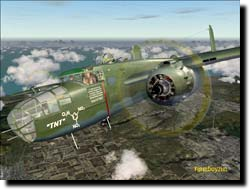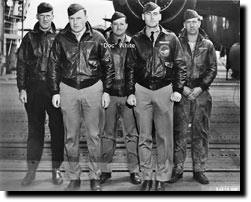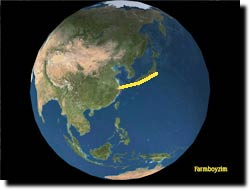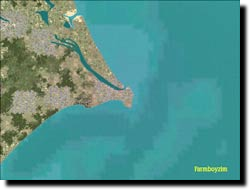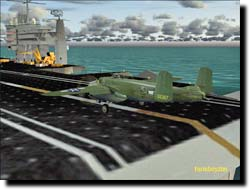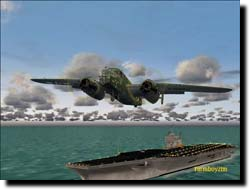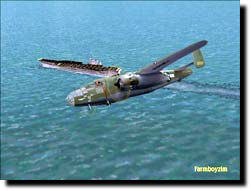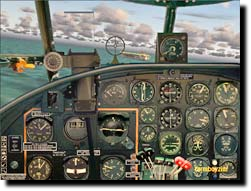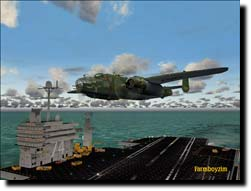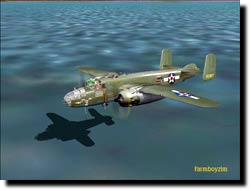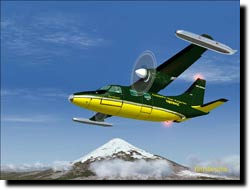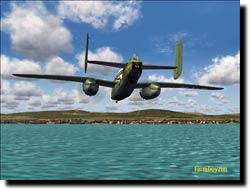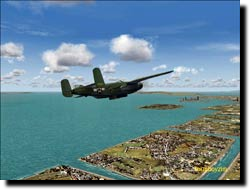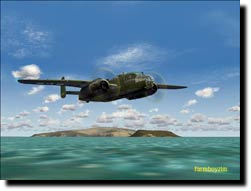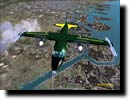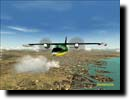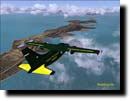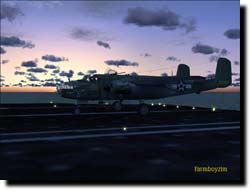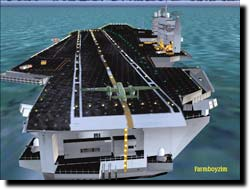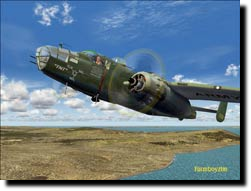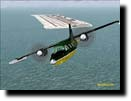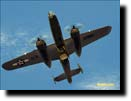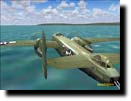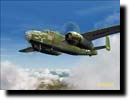Welcome back to Part Two of the story of Major Thomas Robert “Doc” White, M.D. Part One can be found in the Dec/Jan 2010 Issue, or over at my site, Farmboyzim’s Flight Sim’s. “Doc” White was a United States Army Air Corp Flight Doctor, who managed to find a way to be a part of one of the most daring air raids in the history of air warfare. The legendary “Doolittle Raid” of April 1942 is the mission I speak of, and in my opinion is still, to this day, one of the most awe inspiring, courageous air missions ever flown.
This story is taken from the personal memoirs of “Doc” White himself, with additional information furnished graciously to me by his daughter, Vikki White-Hand. The story is told from the perspective of “Doc” White, as he writes of the training, the people and places, and the adventures encountered along the way. At times, while making their way across China, it almost reads like a Travel Guide, except for the fact they were trying to stay one step ahead of the Japanese troops. His is a unique perspective that prompted me to write this story. There were lives that were obviously saved by the actions of “Doc”, but like any good service person, he makes the reader aware of the fact that it took more than just one lone, American doctor, to keep crewmembers, as well as indigenous Chinese civilians and militia members healthy and alive. Here’s a quick update to the point in time when we left “Doc” and the other crew members in the last issue.
This story is taken from the personal memoirs of “Doc” White himself, with additional information furnished graciously to me by his daughter, Vikki White-Hand. The story is told from the perspective of “Doc” White, as he writes of the training, the people and places, and the adventures encountered along the way. At times, while making their way across China, it almost reads like a Travel Guide, except for the fact they were trying to stay one step ahead of the Japanese troops. His is a unique perspective that prompted me to write this story. There were lives that were obviously saved by the actions of “Doc”, but like any good service person, he makes the reader aware of the fact that it took more than just one lone, American doctor, to keep crewmembers, as well as indigenous Chinese civilians and militia members healthy and alive. Here’s a quick update to the point in time when we left “Doc” and the other crew members in the last issue.
The Story of Maj. T. R. "Doc" White
Doctor/Gunner B-25 Doolittle Raid
Crewmember of "TNT"
From the memoirs of "Doc" White
By Harold "Farmboyzim" Zimmer
Doctor/Gunner B-25 Doolittle Raid
Crewmember of "TNT"
From the memoirs of "Doc" White
By Harold "Farmboyzim" Zimmer
The crew of “TNT”; Sessler, Smith, “Doc” White, Williams, Saylor
“Doc” White was serving as a USAAC doctor when, while his unit was preparing for a move, he got wind of requests for volunteer’s for a “secret mission”. Knowing absolutely nothing of what the mission would entail, “Doc” White wanted in and was able to pull some favors and get assigned to the new group that was being formed. These men were sent off for some unique training in the B-25 Mitchell down at Eglin Air Force Base, Florida. Even more unique and the cause of major amounts of “scuttlebutt” was the fact that Lt. Col. James “Jimmy” Doolittle was their commanding officer. The men took an instant liking to Doolittle. Many men trained for this mission, which was still a mystery to the lot of them, but after months of strenuous testing, crews for 16 B-25 Mitchell’s were chosen, as well as a certain amount of reserve crew, and ground crews as well.
MAAM-SIM’s B-25 Mitchell Bomber
They were told to fly across the United States, via a southern route, encouraged to fly as low as they chose too, for additional flight training. After a few stops along the way, the sixteen B-25 Mitchell’s crossed over into Southern California, and then north, with a final destination of Alameda Naval Air Station, which was located right on the San Francisco Bay, nestled beside Oakland and a stone’s throw (or two) from the city of San Francisco. At the Naval Air Station, the aircraft were hoisted onto the deck of the U.S.S. Hornet, a US Naval Aircraft Carrier. Rumors were running rampant at this point, some not too far off the mark, but for the most part, the men were still in the dark as to the final destination and assignment.
Once on board, and the Task Force was underway, the crews of the B-25’s, as well as the naval personnel were finally told that they were on their way to deliver the wars first direct blow to the mainland of Japan. Most had figured out something along those lines already, what with the unusual training back at Eglin Air Force Base, with short take-off’s and low level, cross country flying. It was just a matter of where and when that they could put it all to use. Not knowing what’s going on is one of the most nerve-wracking, stress-inducing feelings there is, especially in the military, so now that the men knew what was expected of them, they could focus even more on their objective. The Naval personnel on board the carrier were also aware of the extreme hazards of the mission, and went out of their way to help the flyers and maintenance crews with anything they needed.
Once on board, and the Task Force was underway, the crews of the B-25’s, as well as the naval personnel were finally told that they were on their way to deliver the wars first direct blow to the mainland of Japan. Most had figured out something along those lines already, what with the unusual training back at Eglin Air Force Base, with short take-off’s and low level, cross country flying. It was just a matter of where and when that they could put it all to use. Not knowing what’s going on is one of the most nerve-wracking, stress-inducing feelings there is, especially in the military, so now that the men knew what was expected of them, they could focus even more on their objective. The Naval personnel on board the carrier were also aware of the extreme hazards of the mission, and went out of their way to help the flyers and maintenance crews with anything they needed.
As soon as the bombs had been released, “TNT” dived low over the water and made for open sea. They passed even more heavily fortified coastal areas and airstrips, again, flying by perhaps noticed, but untouched. The Japanese forces were so disorganized that they had not yet warned their coastal defenses or air defense of the attacks. Once “TNT” was well out to sea, they throttled back and began the journey to China.
So ends Part 2 of “Doc” White’s story. Hope to see you in the April/May Issue as we cross the sea to the coast of China, to begin yet another adventure.
The aircraft used for this article is Mid-Atlantic Air Museums (MAAM-SIM) B-25 Mitchell Bomber, “Briefing Time”, with a repaint by yours truly depicting the aircraft “TNT”. This is not an exact replication of the livery, but a tribute to the men and the machine. The names of the crew are listed on the port side near the nose, with the nose art representing the chemical formula for TNT.
So ends Part 2 of “Doc” White’s story. Hope to see you in the April/May Issue as we cross the sea to the coast of China, to begin yet another adventure.
The aircraft used for this article is Mid-Atlantic Air Museums (MAAM-SIM) B-25 Mitchell Bomber, “Briefing Time”, with a repaint by yours truly depicting the aircraft “TNT”. This is not an exact replication of the livery, but a tribute to the men and the machine. The names of the crew are listed on the port side near the nose, with the nose art representing the chemical formula for TNT.
Click On Any Picture For A Larger View
The morning of he 17th of April, found the two carriers and four cruisers beginning their high speed run in towards the targets in Japan. The destroyer’s were left behind to screen the tankers since they would not have the fuel for the high speed run. The weather was rough, and the skies a dull gray, but the sight of the carriers and cruisers knifing through the wild seas was awe inspiring. It brought home the fact that an incredible amount of time, manpower, and the sheer cost of this operation was enormous. That evening, the crews of the bombers went through the last minute preparations, packing and repacking belongings. This was to be the last night on board the Hornet as the Navy’s guests. Not all slept well that night.
Launch day dawned; April 18, 1942 with seas that were still wild, and the B-25 crews tossed last minute gear into their bags, went to General Quarters for the last time, and ate breakfast in relays. Once assembled in the Ready Room, the crews were given last minute updates as to weather, current position, and the nearest land, which was Point Inubo-Zaki, on the main island of Honshu. After getting briefed, the crews settled into that “hurry-up and wait” mode, but this did not last long. Something was amiss, the bull horns called out to prepare for a high speed turn. In a large ship, traveling at high speeds, there is a tendency for the ship to heel over quite dramatically. This was not the case however and the turn was “rather anti-climactic”, according to “Doc”. The next order over the bull horns however, jarred the crews into action…
Launch day dawned; April 18, 1942 with seas that were still wild, and the B-25 crews tossed last minute gear into their bags, went to General Quarters for the last time, and ate breakfast in relays. Once assembled in the Ready Room, the crews were given last minute updates as to weather, current position, and the nearest land, which was Point Inubo-Zaki, on the main island of Honshu. After getting briefed, the crews settled into that “hurry-up and wait” mode, but this did not last long. Something was amiss, the bull horns called out to prepare for a high speed turn. In a large ship, traveling at high speeds, there is a tendency for the ship to heel over quite dramatically. This was not the case however and the turn was “rather anti-climactic”, according to “Doc”. The next order over the bull horns however, jarred the crews into action…
By Dawn’s Early Light
“ARMY FLIERS, MAN YOUR PLANES…ARMY FLIERS, MAN YOUR PLANES!" The bomber crews knew that they were ten hours ahead of the scheduled launch time, plus the fact they were approximately 250 miles from the planned launch point. Once the crews were scrambled and waiting, “Doc” White did not notice anything immediately imminent, so he settled himself under the wing of “TNT” to await further developments, which were not long in coming. The cruiser “Vincennes” on the Hornet’s port beam suddenly turned, swung her guns about, and let go with a broadside. “Doc” had stated that “the thunder clap which followed nearly took my hat off, but I was so interested in the scene, that its implications did not immediately strike home”. “The sight of a heavy cruiser firing broadside after broadside is an inspiring one. The huge ship is wreathed in smoke and flame”.
Suddenly realizing that this was not target practice, the cruiser was firing on an enemy vessel. They could not see what the “Vincennes” was shooting at right away, but after observing the splashes from the shells, they could finally detect a small craft off in the far distance, which had been identified as a 110 foot Japanese patrol boat. With a puff of black smoke the patrol boat was gone. It took just under three minutes to hit this small vessel, and the marksmanship impressed the aircrews immensely. Unfortunately, in those three minutes, the Japanese boat was able to get a message off, which was intercepted, but could not be read.
Suddenly realizing that this was not target practice, the cruiser was firing on an enemy vessel. They could not see what the “Vincennes” was shooting at right away, but after observing the splashes from the shells, they could finally detect a small craft off in the far distance, which had been identified as a 110 foot Japanese patrol boat. With a puff of black smoke the patrol boat was gone. It took just under three minutes to hit this small vessel, and the marksmanship impressed the aircrews immensely. Unfortunately, in those three minutes, the Japanese boat was able to get a message off, which was intercepted, but could not be read.
Ya gotta be kidding!!!
Figuring the mission had been compromised, with the Japanese now knowing their position, strength, and possible intentions, a revision of plans had to be hastily made. The Navy understandably did not want to sail very much farther towards Japan, as they were sure to meet with heavy surface and air forces. Doolittle met with Captain Mitscher and via blinker with Admiral Halsey. It was decided that the mission would in fact proceed, and the crews would take their chances reaching the Chinese coast. They knew they were over 700 miles from Inubo-Zaki, and at least nine hours ahead of their planned launch time. The crews packed in tins of fuel on board the B-25’s to the point that there was barely enough room to squeeze into the aircraft. An extra 250 miles had just been added to the trip, so the fuel consumption had to be calculated right down to the last drop. With the additional fuel, the gross weight of the aircraft topped out at over 31, 000 pounds, which happened to be record for B-25’s at the time. No celebrations for this record breaking event occurred at the time, needless to say! The extra weight meant extra worry for the pilots, considering the short runway and the wildly pitching seas.
With the crews on board their aircraft, the Hornet turned into the wind and began to pick up speed. One of the cruisers fell into position astern of the Hornet, in case one of the “Mitchell’s” did not make the short take off and ended up in the sea. This was a visual reminder to the men that some of them just might not make it. The pilots had been advised to turn to either the right or left immediately after take off, so that in case the plane and crew did hit the water, the carrier, being unable to stop or turn in time, would have a better chance of avoiding them.
With the crews on board their aircraft, the Hornet turned into the wind and began to pick up speed. One of the cruisers fell into position astern of the Hornet, in case one of the “Mitchell’s” did not make the short take off and ended up in the sea. This was a visual reminder to the men that some of them just might not make it. The pilots had been advised to turn to either the right or left immediately after take off, so that in case the plane and crew did hit the water, the carrier, being unable to stop or turn in time, would have a better chance of avoiding them.
Tail almost over the stern!
Made it!
Circling the carrier
Time for a fly by?
Fly by it is!!!
The collective cheer was loud enough that they thought they would hear it all the way to Tokyo! “Doc” White stated that with all the planes getting off the Hornet safely was a “succession of 16 miracles!” Doolittle circled around and passed over the ship, checking his compass and bearings, and then headed off towards Japan. Each of the planes in turn, thundered down the deck of the Hornet, hopes and confidence buoyed by the fact that Doolittle made it off the deck in one piece! “Doc” recalled some very close calls. One aircraft, he believed it to be Lawson’s, dropped out of sight over the bow of the Hornet, and everyone thought she was lost. But as the ship settled into a trough in the sea, the aircraft could be seen just skimming the tops of the waves!
It was finally time for the “TNT” and her crew to take off. They fired up the engines, listening for any sign of trouble out of the number 2 engine, but it was running smooth. Navy handlers with ropes aided in positioning the aircraft for take off, as the tossing of the ship, combined with the wet surface had the B-25 going this way and that. With the “TNT” in position for launch, and with engines revving, the pilot eagerly watched the “Starter” for the go ahead, and at just the right moment, the signal was given. Full flaps, brakes released and throttles jammed nearly forward, the “TNT” rolled down the deck of the Hornet, with the crew mentally lifting the aircraft into the air. As the “TNT” made its run down the deck of the Hornet, the ship suddenly hit a large wave and the aircraft was literally tossed into the air. Hanging in midair, just above stall speed, “TNT” showed what she was made of and pulled out and began to climb. Everyone looked at each other in amazement that they had made it!
It was finally time for the “TNT” and her crew to take off. They fired up the engines, listening for any sign of trouble out of the number 2 engine, but it was running smooth. Navy handlers with ropes aided in positioning the aircraft for take off, as the tossing of the ship, combined with the wet surface had the B-25 going this way and that. With the “TNT” in position for launch, and with engines revving, the pilot eagerly watched the “Starter” for the go ahead, and at just the right moment, the signal was given. Full flaps, brakes released and throttles jammed nearly forward, the “TNT” rolled down the deck of the Hornet, with the crew mentally lifting the aircraft into the air. As the “TNT” made its run down the deck of the Hornet, the ship suddenly hit a large wave and the aircraft was literally tossed into the air. Hanging in midair, just above stall speed, “TNT” showed what she was made of and pulled out and began to climb. Everyone looked at each other in amazement that they had made it!
“Hey! You’re scaring the fish!”
Once airborne, the crew raised flaps and gear, throttled back to minimum cruise, and settled in for the long ride to the targets in Japan. “TNT” followed behind Jack Hilger’s plane, close to the water. Flying low meant it was harder to spot from both surface ships and aircraft. If the Japanese had radar, as their allies the German’s did, their “blip” may be mistaken for a wave or some other anomaly. As they flew along at about 50 feet off the water, they would empty the gas cans that were on board into the fuel tanks, and then puncture them so they would sink and not be found by the enemy. Having left the Hornet, each of the planes had a thirty minute grace period in which to return to the carrier, in the event of engine trouble or other such problems.
After nearly two hours of not seeing any Japanese ships, small steamers that sailed in between the islands could be seen off in the distance. “TNT” and her crew flew close by some of these ships, apparently not causing any concern. At one point, the passengers of one ship waved their handkerchiefs at the planes as they flew over, mistakenly believing that they were Japanese aircraft. They had a similar twin-engine plane, and the US aircraft at the time still had the red spot in the middle of the white star on blue background. The Japanese saw the red spot, “they saw the stars later” according to “Doc”. Expecting a “welcoming committee” at any moment, the crew was surprised that they were still flying unmolested. Getting closer to land, there were more sampans and small fishing boats, but still, no unwelcome “disturbances” “Doc” White admitted that they did pass low over a small boat, where the fisherman on board ended up in the water!
After nearly two hours of not seeing any Japanese ships, small steamers that sailed in between the islands could be seen off in the distance. “TNT” and her crew flew close by some of these ships, apparently not causing any concern. At one point, the passengers of one ship waved their handkerchiefs at the planes as they flew over, mistakenly believing that they were Japanese aircraft. They had a similar twin-engine plane, and the US aircraft at the time still had the red spot in the middle of the white star on blue background. The Japanese saw the red spot, “they saw the stars later” according to “Doc”. Expecting a “welcoming committee” at any moment, the crew was surprised that they were still flying unmolested. Getting closer to land, there were more sampans and small fishing boats, but still, no unwelcome “disturbances” “Doc” White admitted that they did pass low over a small boat, where the fisherman on board ended up in the water!
Mt. Fuji and the Mitsubishi
MU-2 Solitaire
MU-2 Solitaire
Thirteen planes were sent to Tokyo, Yokosuka, and Yokahama. These three cities literally formed one continuous city, on the shores of Tokyo Bay. Hilger’s plane went to Nagoya, Farrow’s to Osaka, and “TNT” flew to Kobe, which was the location of a Japanese Naval Base. As the crew of “TNT” flew past the mouth of Tokyo Bay, they could see Mt. Fuji off in the distance, framed by the smoke from the fires of the earlier bomb damage.
At about 1430, Hilger waggled his wings at “TNT” and turned off toward Nagoya, proceeding up and over a hill for the element of surprise. As “TNT” continued on, they encountered their first opposition as they zoomed low over the beach. Four small boys, who had been playing along the shoreline, threw rocks as the bomber skimmed over their heads! At this point in the journey, it had been about an hour since Tokyo had been bombed, so the crew redoubled their vigilance for enemy interceptors. They had been briefed that there were some 800 first rate Japanese planes and pilots on the home island, yet, to their surprise, they continued on without seeing a single Japanese plane or the familiar puffs of smoke that warned of antiaircraft artillery.
“Doc” White climbed back to the photographer’s compartment, and began to frantically take pictures of anything and everything that may be of military interest, including the aerodromes that they began to pass over, without a single one of them launching a plane. The crew could not figure out why there was such a lack of opposition, and wrote it off to either the Japanese not hearing the warning from the patrol boat, or perhaps simply ignoring it altogether, not really believing that any part of Japan could be attacked. It was an underestimation on their part. Later on, “Doc” recalled one of the pilots telling him that they had tuned in to the predecessor to “Tokyo Rose”, broadcasting how wonderful Japan was, with the cherry blossoms, no threat of bombs, etc. Ironically, her broadcast was cut short with news and warnings of the bombings that were taking place.
At about 1430, Hilger waggled his wings at “TNT” and turned off toward Nagoya, proceeding up and over a hill for the element of surprise. As “TNT” continued on, they encountered their first opposition as they zoomed low over the beach. Four small boys, who had been playing along the shoreline, threw rocks as the bomber skimmed over their heads! At this point in the journey, it had been about an hour since Tokyo had been bombed, so the crew redoubled their vigilance for enemy interceptors. They had been briefed that there were some 800 first rate Japanese planes and pilots on the home island, yet, to their surprise, they continued on without seeing a single Japanese plane or the familiar puffs of smoke that warned of antiaircraft artillery.
“Doc” White climbed back to the photographer’s compartment, and began to frantically take pictures of anything and everything that may be of military interest, including the aerodromes that they began to pass over, without a single one of them launching a plane. The crew could not figure out why there was such a lack of opposition, and wrote it off to either the Japanese not hearing the warning from the patrol boat, or perhaps simply ignoring it altogether, not really believing that any part of Japan could be attacked. It was an underestimation on their part. Later on, “Doc” recalled one of the pilots telling him that they had tuned in to the predecessor to “Tokyo Rose”, broadcasting how wonderful Japan was, with the cherry blossoms, no threat of bombs, etc. Ironically, her broadcast was cut short with news and warnings of the bombings that were taking place.
The moment came when the bull horns blared out the orders to “STAND CLEAR OF THE PROPELLERS!” The excitement had just begun. “START YOUR MOTORS” was the next command bellowed out, and Lt. Col. Jimmy Doolittle was the first to start his engines, and shortly thereafter, the #2 and #3 planes started theirs. So far, so good! Doolittle had about 50 feet less runway than the other fifteen planes, and all the aircrews knew this and held their breaths as the “Starter”, the man on deck who would give the “GO” for launch at just the right time, waited for the deck to be almost level, then gave the “GO” to Doolittle. It seemed to the men in the other planes that Doolittle’s plane was moving horrifyingly slow, but gradually the aircraft picked up speed, the nose wheel lifted, and then at the last possible second, the main gear left the deck. The aircraft dropped a bit, but lifted and gained altitude.
Coming in low!
As “TNT” crossed a ridge into Osaka, they ran into the heavy smoke haze that typically surrounds the area, due to the industrial make up of the area. It had been ninety minutes since the raid on Tokyo, but as far as the crew could tell, it was business as usual down below with trains running; buses and street cars travelling back and forth, and they even passed a civilian passenger aircraft. As “TNT” approached Kobe, a sea breeze blew the haze away and they could see the target area clearly. “Doc” White was taking pictures and movies like a madman, as the area was loaded with factories.
At 1515, Japanese time, “TNT” climbed to 1500 feet and let loose her bombs. One cluster hit a warehouse, one into a freight yard, and the last two hit an aircraft assembly plant. “It was a strange sight, seeing the air filled with those green and black sticks, and then I realized they were our incendiary bombs!” On the way out of the area, they passed over a Japanese carrier that was getting its finishing touches before being launched. The entire crew wished at the same time for just one more demo bomb! Sessler told “Doc” later that he couldn’t have missed it blindfolded!
At 1515, Japanese time, “TNT” climbed to 1500 feet and let loose her bombs. One cluster hit a warehouse, one into a freight yard, and the last two hit an aircraft assembly plant. “It was a strange sight, seeing the air filled with those green and black sticks, and then I realized they were our incendiary bombs!” On the way out of the area, they passed over a Japanese carrier that was getting its finishing touches before being launched. The entire crew wished at the same time for just one more demo bomb! Sessler told “Doc” later that he couldn’t have missed it blindfolded!
“TNT” over Kobe dockyards
Last of the small Japanese islands before China
Tail markings and other markings are accurate. The “Briefing Time” model is excellent, and if you don’t have it in your virtual hanger, you should. Proceeds from the sale of the model goes toward keeping the real “Briefing Time” in shape and flyable.
I used the FS2004 Mitsubishi MU-2 Solitaire 6 seat twin turbo-prop corporate & executive transport. This model has full animation, dynamic shine & reflective textures. It includes a 2D Panel and VC with a complete passenger cabin. Full package for FS2004. By Jean-Pierre Brisard, Bob May, Joe Zerilli, of Premier Aircraft Design. Custom paint job by yours truly, “Farmboyzim”.
FS2004 Scenery--CV-74 USS Stennis
File name - cv_74.zip FS2004 Scenery--CV-74 USS Stennis. This scenery object is an update from the previous version which had a hardened deck and a carrier wake effect. It now has deck lights, fantail lights, more visible arrestor cables, rotating beacon and a rotating radar antenna.. It is presently located just off the San Diego Naval Station, California (CA). The text files for the rcbco-20 catapult and arrestor zones are also included. By Paul Clawson
I also used FS Environment and Ground Environment Pro, from Flight1 for those outstanding textures you see on the ground and in the air! CH Products are my “gear of choice” for my flights as well.
I want to thank Victoria White-Hand, the daughter of “Doc” White, for sharing this information with me and allowing me to tell her fathers story. Meeting her and listening to her stories of her father, has put a more personal feeling in the story for me, for which I am deeply grateful!
I used the FS2004 Mitsubishi MU-2 Solitaire 6 seat twin turbo-prop corporate & executive transport. This model has full animation, dynamic shine & reflective textures. It includes a 2D Panel and VC with a complete passenger cabin. Full package for FS2004. By Jean-Pierre Brisard, Bob May, Joe Zerilli, of Premier Aircraft Design. Custom paint job by yours truly, “Farmboyzim”.
FS2004 Scenery--CV-74 USS Stennis
File name - cv_74.zip FS2004 Scenery--CV-74 USS Stennis. This scenery object is an update from the previous version which had a hardened deck and a carrier wake effect. It now has deck lights, fantail lights, more visible arrestor cables, rotating beacon and a rotating radar antenna.. It is presently located just off the San Diego Naval Station, California (CA). The text files for the rcbco-20 catapult and arrestor zones are also included. By Paul Clawson
I also used FS Environment and Ground Environment Pro, from Flight1 for those outstanding textures you see on the ground and in the air! CH Products are my “gear of choice” for my flights as well.
I want to thank Victoria White-Hand, the daughter of “Doc” White, for sharing this information with me and allowing me to tell her fathers story. Meeting her and listening to her stories of her father, has put a more personal feeling in the story for me, for which I am deeply grateful!
“TNT” over Point Inubo-Zaki
Route of “TNT” from Hornet to
China coast
China coast
Point Inubo-Zaki
Dock areas of Kobe
Kobe, Japan
Loads of islands to explore
Wall-to-Wall Tokyo!
Ahhh! Green Space!
Mt. Fuji
Kansai International, Osaka RJBB
Kansai Intl., an “Island” airport
Ready to drop
Heading out to sea after the strike
In the clear!...So far!
Here's a few more screenshots of the areas...

* MSFS2004/FS9 * FSX *
* Train and Ship Sims *
* Games *
* Train and Ship Sims *
* Games *
* Reviews * Articles *
* Tutorials *
* Forums * Events *
* Multi-Player Server *
* TeamSpeak Server *
* Tutorials *
* Forums * Events *
* Multi-Player Server *
* TeamSpeak Server *
- Home
- Product Reviews
- Articles
- Tutorials/How-To's
- Movie and Book Reviews
- Downloads
- Forum
- Aviation Video's
- Flight Sim Video's
- Multiplayer Server
- Team Speak Server
- Screenshot Gallery
- Maps
- FS Links
- Certificates
- ICAO Codes Index
- Weather Info
